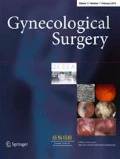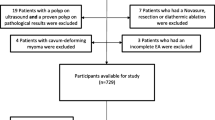Abstract
The objective of the cohort study was to identify clinical factors that influence the rate of further surgical intervention in women who had endometrial ablation. Electronic databases and patient records were scrutinised to obtain examination, investigative and procedural data considered to be potentially predictive of the need for further surgical intervention after endometrial ablation in the office setting. A total of 391 consecutive women were identified who received endometrial ablation in the office setting between July 2005 and December 2012, with an average follow-up of 4.3 years. Univariable and multivariable logistic regressions were used to estimate the influence of these variables on prognosis. Factors predictive of further surgical treatment were dysmenorrhea (odds ratio [OR] 4.01; 95 % CI 1.63 to 9.91) and a uterine cavity length >9 cm (OR 2.65; 95 % CI 1.33 to 5.27). In conclusion, dysmenorrhoea before treatment or a uterine cavity length >9 cm was associated with the need for further surgical interventions after office endometrial ablation. These findings should help inform clinician and patient upon decision-making when considering treatment options for heavy menstrual bleeding.
Similar content being viewed by others
References
Côté I, Jacobs P, Cumming DC (2003) Use of health services associated with increased menstrual loss in the United States. Am J Obstet Gynecol 188(2):343–8
Coulter A, Bradlow J, Agass M, Martin-Bates C, Tulloch A (1991) Outcomes of referrals to gynaecology outpatient clinics for menstrual problems: an audit of general practice records. Br J Obstet Gynaecol 98(8):789–96
NICE (2007) Heavy Menstrual Bleeding. Clinical Guideline No. 44. National Collaborating Centre for Women’s and Children’s Health Commissioned by the National Institute for Health and Clinical Excellence. RCOG Press: London. Available at: https://www.nice.org.uk/guidance/cg44.
Dickersin K, Munro MG, Clark M, Langenberg P, Scherer R, Frick K et al (2007) Hysterectomy compared with endometrial ablation for dysfunctional uterine bleeding: a randomized controlled trial. Obstet Gynecol 110(6):1279–89
Daniels JP, Middleton LJ, Champaneria R, Khan KS, Cooper K, Mol BWJ et al (2012) Second generation endometrial ablation techniques for heavy menstrual bleeding: network meta-analysis. BMJ 344:e2564
Kleijn JH, Engels R, Bourdrez P, Mol BWJ, Bongers MY (2008) Five-year follow up of a randomised controlled trial comparing NovaSure and ThermaChoice endometrial ablation. BJOG Int J Obstet Gynaecol 115(2):193–8
Peeters JAH, Penninx JPM, Mol BW, Bongers MY (2013) Prognostic factors for the success of endometrial ablation in the treatment of menorrhagia with special reference to previous cesarean section. Eur J Obstet Gynecol Reprod Biol 167(1):100–3
El-Nashar SA, Hopkins MR, Creedon DJ, St Sauver JL, Weaver AL, McGree ME et al (2009) Prediction of treatment outcomes after global endometrial ablation. Obstet Gynecol 113(1):97–106
Middleton LJ, Champaneria R, Daniels JP, Bhattacharya S, Cooper KG, Hilken NH et al (2010) Hysterectomy, endometrial destruction, and levonorgestrel releasing intrauterine system (Mirena) for heavy menstrual bleeding: systematic review and meta-analysis of data from individual patients. BMJ 341:c3929
Smith PP, Malick S, Clark TJ (2014) Bipolar radiofrequency compared with thermal balloon ablation in the office: a randomized controlled trial. Obstet Gynecol 124(2 Pt 1):219–25
Jack SA, Cooper KG, Seymour J, Graham W, Fitzmaurice A, Perez J (2005) A randomised controlled trial of microwave endometrial ablation without endometrial preparation in the outpatient setting: patient acceptability, treatment outcome and costs. BJOG Int J Obstet Gynaecol 112(8):1109–16
Clark TJ, Samuels N, Malick S, Middleton L, Daniels J, Gupta J (2011) Bipolar radiofrequency compared with thermal balloon endometrial ablation in the office: a randomized controlled trial. Obstet Gynecol 117(5):1228
Tresserra F, Grases P, Ubeda A, Pascual MA, Grases PJ, Labastida R (1999) Morphological changes in hysterectomies after endometrial ablation. Hum Reprod Oxf Engl 14(6):1473–7
Longinotti MK, Jacobson GF, Hung Y-Y, Learman LA (2008) Probability of hysterectomy after endometrial ablation. Obstet Gynecol 112(6):1214–20
Bansi-Matharu L, Gurol-Urganci I, Mahmood TA, Templeton A, van der Meulen JH, Cromwell DA (2013) Rates of subsequent surgery following endometrial ablation among English women with menorrhagia: population-based cohort study. BJOG Int J Obstet Gynaecol 120(12):1500–7
Gemer O, Kruchkovich J, Huerta M, Kapustian V, Kroll D, Anteby E (2007) Perioperative predictors of successful hysteroscopic endometrial ablation. Gynecol Obstet Invest 63(4):205–8
Contribution to authorship
PS collected data, performed the analyses and drafted the article. SK collected data and revised the article. TJC produced the original idea, contributed to interpretation and revised the article for important intellectual content.
Author information
Authors and Affiliations
Corresponding author
Ethics declarations
Compliance with ethical standards
Data collection and storage satisfied local and national regulations. Ethical approval was not required.
Conflict of interest
T. Justin Clark has received research monies from Cytyc (now Hologic) for the administration costs of the thermal balloon compared to bipolar radiofrequency ablation trial. In addition to this, he has received honoraria from Hologic and Gynecare to run training workshops in office hysteroscopy techniques. The other authors did not report any potential conflicts of interest.
Funding
None
Rights and permissions
About this article
Cite this article
Smith, P.P., Karpate, S. & Clark, T.J. Prognostic factors that predict success in office endometrial ablation: a retrospective study. Gynecol Surg 13, 83–87 (2016). https://doi.org/10.1007/s10397-015-0921-5
Received:
Accepted:
Published:
Issue Date:
DOI: https://doi.org/10.1007/s10397-015-0921-5




